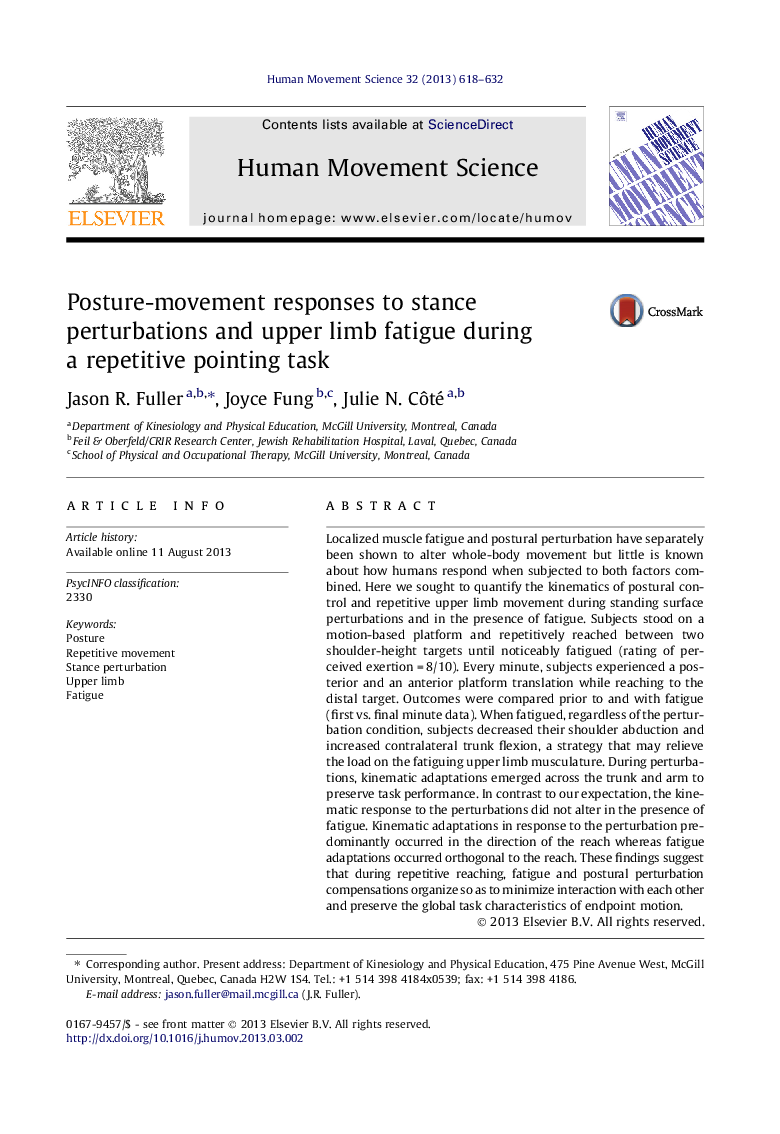| کد مقاله | کد نشریه | سال انتشار | مقاله انگلیسی | نسخه تمام متن |
|---|---|---|---|---|
| 10459192 | 922368 | 2013 | 15 صفحه PDF | دانلود رایگان |
عنوان انگلیسی مقاله ISI
Posture-movement responses to stance perturbations and upper limb fatigue during a repetitive pointing task
ترجمه فارسی عنوان
پاسخ مثبت به حرکت موضعی حرکتی به اختلالات موضعی و خستگی اندام فوقانی در طی یک کار اشاره گر تکراری است
دانلود مقاله + سفارش ترجمه
دانلود مقاله ISI انگلیسی
رایگان برای ایرانیان
کلمات کلیدی
2330، پوسیدگی، حرکت تکراری، اختلال در وضعیت، اندام فوقانی، خستگی،
موضوعات مرتبط
علوم زیستی و بیوفناوری
علم عصب شناسی
علوم اعصاب شناختی
چکیده انگلیسی
Localized muscle fatigue and postural perturbation have separately been shown to alter whole-body movement but little is known about how humans respond when subjected to both factors combined. Here we sought to quantify the kinematics of postural control and repetitive upper limb movement during standing surface perturbations and in the presence of fatigue. Subjects stood on a motion-based platform and repetitively reached between two shoulder-height targets until noticeably fatigued (rating of perceived exertion = 8/10). Every minute, subjects experienced a posterior and an anterior platform translation while reaching to the distal target. Outcomes were compared prior to and with fatigue (first vs. final minute data). When fatigued, regardless of the perturbation condition, subjects decreased their shoulder abduction and increased contralateral trunk flexion, a strategy that may relieve the load on the fatiguing upper limb musculature. During perturbations, kinematic adaptations emerged across the trunk and arm to preserve task performance. In contrast to our expectation, the kinematic response to the perturbations did not alter in the presence of fatigue. Kinematic adaptations in response to the perturbation predominantly occurred in the direction of the reach whereas fatigue adaptations occurred orthogonal to the reach. These findings suggest that during repetitive reaching, fatigue and postural perturbation compensations organize so as to minimize interaction with each other and preserve the global task characteristics of endpoint motion.
ناشر
Database: Elsevier - ScienceDirect (ساینس دایرکت)
Journal: Human Movement Science - Volume 32, Issue 4, August 2013, Pages 618-632
Journal: Human Movement Science - Volume 32, Issue 4, August 2013, Pages 618-632
نویسندگان
Jason R. Fuller, Joyce Fung, Julie N. Côté,
